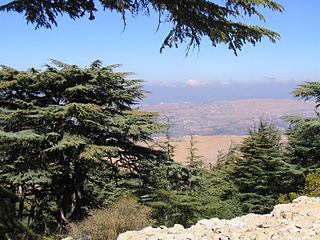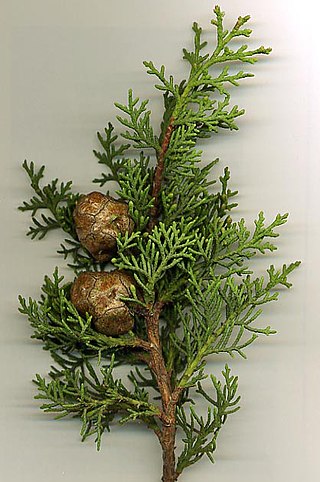
A pine is any conifer tree or shrub in the genus Pinus of the family Pinaceae. Pinus is the sole genus in the subfamily Pinoideae.

Cedrus, with the common English name cedar, is a genus of coniferous trees in the plant family Pinaceae. They are native to the mountains of the western Himalayas and the Mediterranean region, occurring at altitudes of 1,500–3,200 m in the Himalayas and 1,000–2,200 m in the Mediterranean.

Conifers are a group of cone-bearing seed plants, a subset of gymnosperms. Scientifically, they make up the division Pinophyta, also known as Coniferophyta or Coniferae. The division contains a single extant class, Pinopsida. All extant conifers are perennial woody plants with secondary growth. The great majority are trees, though a few are shrubs. Examples include cedars, Douglas-firs, cypresses, firs, junipers, kauri, larches, pines, hemlocks, redwoods, spruces, and yews. As of 2002, Pinophyta contained seven families, 60 to 65 genera, and more than 600 living species.

A spruce is a tree of the genus Picea, a genus of about 40 species of coniferous evergreen trees in the family Pinaceae, found in the northern temperate and boreal (taiga) regions of the Earth. Picea is the sole genus in the subfamily Piceoideae. Spruces are large trees, from about 20 to 60 m tall when mature, and have whorled branches and conical form.

Araucariaceae – also known as araucarians – is a family of coniferous trees, with three living genera, Araucaria, Agathis, and Wollemia. While the family was distributed globally during the Jurassic and Cretaceous periods, in their native distribution they are now largely confined to the Southern Hemisphere, except for a few species of Agathis in Southeast Asia.

Gnetophyta is a division of plants, grouped within the gymnosperms, that consists of some 70 species across the three relict genera: Gnetum, Welwitschia, and Ephedra. The earliest unambiguous records of the group date to the Jurassic, and they achieved their highest diversity during the Early Cretaceous. The primary difference between gnetophytes and other gymnosperms is the presence of vessel elements, a system of small tubes (xylem) that transport water within the plant, similar to those found in flowering plants. Because of this, gnetophytes were once thought to be the closest gymnosperm relatives to flowering plants, but more recent molecular studies have brought this hypothesis into question, with many recent phylogenies finding them to be nested within the conifers.

The gymnosperms are a group of seed-producing plants that includes conifers, cycads, Ginkgo, and gnetophytes, forming the clade Gymnospermae. The term gymnosperm comes from the composite word in Greek: γυμνόσπερμος, literally meaning 'naked seeds'. The name is based on the unenclosed condition of their seeds. The non-encased condition of their seeds contrasts with the seeds and ovules of flowering plants (angiosperms), which are enclosed within an ovary. Gymnosperm seeds develop either on the surface of scales or leaves, which are often modified to form cones, or on their own as in yew, Torreya, Ginkgo. Gymnosperm lifecycles involve alternation of generations. They have a dominant diploid sporophyte phase and a reduced haploid gametophyte phase which is dependent on the sporophytic phase. The term "gymnosperm" is often used in paleobotany to refer to all non-angiosperm seed plants. In that case, to specify the modern monophyletic group of gymnosperms, the term Acrogymnospermae is sometimes used.

Araucaria is a genus of evergreen coniferous trees in the family Araucariaceae. While today they are largely confined to the Southern Hemisphere, during the Jurassic and Cretaceous they were distributed globally. There are 20 extant species in New Caledonia, Norfolk Island, eastern Australia, New Guinea, Argentina, Brazil and Chile.

Cupressaceae is a conifer family, the cypress, with worldwide distribution. The family includes 27–30 genera, which include the junipers and redwoods, with about 130–140 species in total. They are monoecious, subdioecious or (rarely) dioecious trees and shrubs up to 116 m (381 ft) tall. The bark of mature trees is commonly orange- to red-brown and of stringy texture, often flaking or peeling in vertical strips, but smooth, scaly or hard and square-cracked in some species.

Pinus lambertiana is the tallest and most massive pine tree, and has the longest cones of any conifer. The species name lambertiana was given by the Scottish botanist David Douglas, who named the tree in honour of the English botanist, Aylmer Bourke Lambert. It is native to coastal and inland mountain areas along the Pacific coast of North America, as far north as Oregon and as far south as Baja California in Mexico.

Pinus serotina, the pond pine, black bark pine, bay pine,marsh pine, or pocosin pine, is a pine tree found along the Southeastern portion of the Atlantic coastal plain of the United States, from southern New Jersey south to Florida and west to southern Alabama. Pond pine distribution may be starting to spread west towards Mississippi and Tennessee.

Pinus pinaster, the maritime pine or cluster pine, is a pine native to the south Atlantic Europe region and parts of the western Mediterranean. It is a hard, fast growing pine bearing small seeds with large wings.

Methyl jasmonate is a volatile organic compound used in plant defense and many diverse developmental pathways such as seed germination, root growth, flowering, fruit ripening, and senescence. Methyl jasmonate is derived from jasmonic acid and the reaction is catalyzed by S-adenosyl-L-methionine:jasmonic acid carboxyl methyltransferase.

Serotiny in botany simply means 'following' or 'later'.
Pinus matthewsii is an extinct species of conifer in the pine family. The species is solely known from the Pliocene sediments exposed at Ch’ijee's Bluff on the Porcupine River near Old Crow, Yukon, Canada.

The Laricoideae are a subfamily of the Pinaceae, a Pinophyta division family. They take their name from the genus Larix (larches), which contains inside most of the species of the group and is one of only two deciduous genera of the pines complex. Ecologically important trees, the Laricoideae form pure or mixed forest associations often dominant in the ecosystems in which they are present, thanks also to their biological adaptations to natural disturbances, to reproductive strategies put in place and high average longevity of the individuals. Currently are assigned to this subfamily three genera and its members can be found only in Northern Hemisphere. The various species live for the most part in temperate or cold climates and are the more northerly conifers; some constitute an important source of timber and non-timber forest products.
Eathiestrobus mackenziei is a fossil pine cone found in the Kimmeridge Clay Formation near Eathie, on the Black Isle in Scotland. It is the oldest fossil pine currently known.

Pararaucaria is a genus of conifer cone belonging to the extinct family Cheirolepidiaceae. Fossils are known from the Lower Jurassic to Early Cretaceous of North America, Europe, South America and Asia. It is associated with Brachyphyllum-type foliage.





















